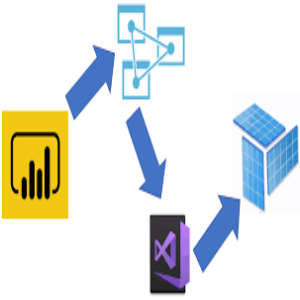SSAS 2008 Practice Test

This Microsoft SQL Server Analysis Services, SSAS, quiz has been compiled to cover different aspects of SSAS, so it will be of great benefit to you if you take it. Click the start button to get started, Good Luck!
- 1.
They are how many types of data mart?
- A.
1
- B.
2
- C.
3
- D.
4
Correct Answer
C. 3Explanation
There are three types of data marts. A data mart is a subset of a data warehouse that is focused on a specific functional area or department within an organization. The three types of data marts are: dependent data mart, independent data mart, and hybrid data mart. A dependent data mart relies on a data warehouse for its data, an independent data mart does not rely on a data warehouse and has its own data sources, and a hybrid data mart combines elements of both dependent and independent data marts.Rate this question:
-
- 2.
The types of data mart include:
- A.
Dependent
- B.
Independent
- C.
Logical data mart
- D.
All of the above
Correct Answer
D. All of the aboveExplanation
The correct answer is "All of the above" because the types of data mart mentioned in the question are all valid and commonly used. A dependent data mart is created from a centralized data warehouse and focuses on a specific department or business unit. An independent data mart is created separately from the data warehouse and serves a specific business function or user group. A logical data mart is a virtual data mart that is created on-the-fly using views or queries. Therefore, all three types mentioned in the question are valid options for data marts.Rate this question:
-
- 3.
SQL expression represented as a calculated column is a/an
- A.
Named calculation
- B.
Expressed calculation
- C.
Column calculation
- D.
Row calculation
Correct Answer
A. Named calculationExplanation
A named calculation in SQL is an expression that is defined and named within a query or a view. It allows users to create a calculated column by specifying the expression and assigning it a name. This named calculation can then be referenced in other parts of the query or view, making it easier to reuse the calculated value. Therefore, a named calculation is the correct answer for a SQL expression represented as a calculated column.Rate this question:
-
- 4.
The fact table consist of how many sections?
- A.
1
- B.
2
- C.
3
- D.
4
Correct Answer
B. 2Explanation
The fact table consists of two sections.Rate this question:
-
- 5.
There are how many types of dimensions?
- A.
1
- B.
2
- C.
3
- D.
4
Correct Answer
C. 3Explanation
There are three types of dimensions.Rate this question:
-
- 6.
The dimension which is sharable across the multiple facts or data model is known as
- A.
Degenerate attribute
- B.
Junk dimension
- C.
Confirm dimension
- D.
None of the above
Correct Answer
C. Confirm dimensionExplanation
A confirm dimension is a dimension that is shared across multiple facts or data models. It serves as a common reference point for different sets of data. Unlike degenerate attributes, which are specific to a single fact, or junk dimensions, which are used to group low cardinality attributes, a confirm dimension provides a consistent and standardized way to analyze and compare data across different data sets. Therefore, the correct answer is confirm dimension.Rate this question:
-
- 7.
Fact table is directly linked with all dimension tables in which type of database schema?
- A.
Star
- B.
Snowflake
- C.
Starflake
- D.
None of the above
Correct Answer
A. StarExplanation
In a star schema, the fact table is directly linked with all dimension tables. This means that the fact table serves as the central table in the schema, with the dimension tables connected to it through foreign key relationships. The star schema is a simple and denormalized structure, making it easier to understand and query. It is commonly used in data warehousing and business intelligence applications where fast query performance is essential. The snowflake schema, on the other hand, involves normalizing the dimension tables, resulting in more complex relationships. The starflake schema is not a recognized type of database schema. Therefore, the correct answer is star.Rate this question:
-
- 8.
There are how many types of hierarchies?
- A.
4
- B.
3
- C.
2
- D.
1
Correct Answer
C. 2Explanation
The given answer is 2 because hierarchies can be categorized into two main types: vertical and horizontal. Vertical hierarchies represent the traditional top-down structure where authority and decision-making flow from higher-level positions to lower-level positions. Horizontal hierarchies, on the other hand, represent a more collaborative and flat organizational structure where decision-making is decentralized and employees have more autonomy.Rate this question:
-
- 9.
The following are the standard storage modes in OLAP applications except:
- A.
MOLAP
- B.
ROLAP
- C.
HOLAP
- D.
JOLAP
Correct Answer
D. JOLAPExplanation
JOLAP is not a standard storage mode in OLAP applications. MOLAP stands for Multidimensional OLAP, which stores data in a multidimensional cube format. ROLAP stands for Relational OLAP, which uses a relational database to store data. HOLAP stands for Hybrid OLAP, which combines the features of both MOLAP and ROLAP. JOLAP, on the other hand, does not exist as a standard storage mode in OLAP applications.Rate this question:
-
- 10.
The dimension table is joined to an intermediate table, which in turn, is joined to the fact table in which type of relation?
- A.
Fact
- B.
Data mining
- C.
Regular
- D.
Referenced
Correct Answer
D. ReferencedExplanation
In a referenced relation, the dimension table is joined to an intermediate table, which is then joined to the fact table. This means that the intermediate table serves as a bridge between the dimension and fact tables, allowing for a more complex relationship between the two.Rate this question:
-
Quiz Review Timeline +
Our quizzes are rigorously reviewed, monitored and continuously updated by our expert board to maintain accuracy, relevance, and timeliness.
-
Current Version
-
Mar 21, 2023Quiz Edited by
ProProfs Editorial Team -
Mar 16, 2018Quiz Created by
Stephanie Young
 Back to top
Back to top












